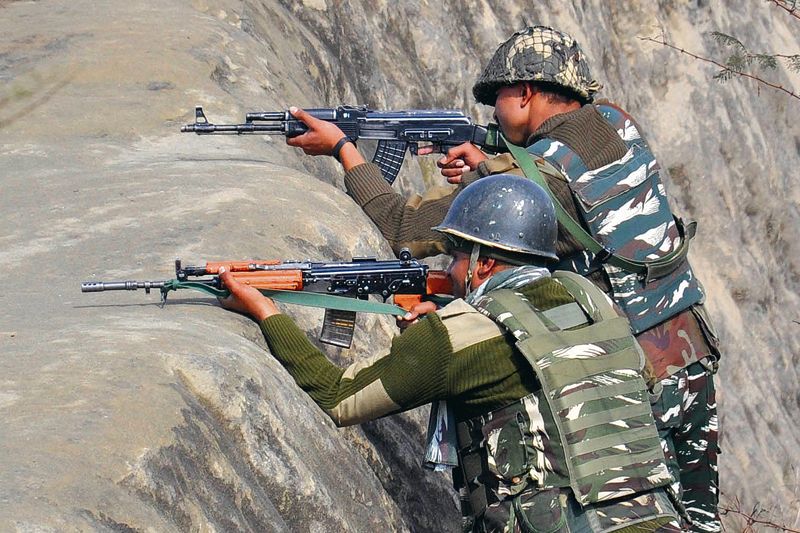
Key: The security forces have a critical role to play in the coming months to ensure normalcy. File Photo
Lt Gen SK Saini (Retd)
Former Vice Chief of Army Staff
PRIME Minister Narendra Modi visited Jammu on February 20 and Srinagar on March 7. During these visits, his first to J&K since the abrogation of Article 370 in August 2019, he inaugurated and laid the foundation stone of development projects in sectors such as education, railways, aviation, roads and skilling infrastructure. The Election Commission is holding meetings to assess whether Assembly elections can be held in the union territory (UT) alongside the Lok Sabha polls. These reflect positive changes in the security dynamics in J&K. Of particular significance is the PM’s visit to Kashmir, perceived to be the hub of separatism and terrorism. Meanwhile, the composition of terrorist cadres in J&K has gradually mutated yet again, and it will throw up fresh challenges for the security forces.
The J&K DGP, during his annual press conference on December 30, 2023, said: “Local terrorists are gasping for breath, while foreigners are taking the lead in numbers. It becomes clear that the future fight will be against those who infiltrate into Jammu and Kashmir.” As per official data, out of the 91 active terrorists in 2023, 61 were foreign and 30 of local origin. At present, foreign terrorists (FTs) are mostly Pakistani nationals recruited and trained in that country, while local terrorists (LTs) are Indian nationals, some of whom travel to Pakistan for training.
In recent years, this ratio was in favour of LTs, but it started reversing in 2022. According to figures from the Army, in April 2022, the ratio of local and foreign militants operating in Kashmir was 50:50. At that juncture, out of the 156 militants active in the Kashmir valley, 79 were locals and the rest foreigners. Between 2019 and 2022, around 750 militants were killed in the erstwhile state, 83 per cent of whom were locals. This ratio has inversed many times since 1990, and it has had a profound impact on the intensity and violence levels.
Terrorism in J&K has passed through a series of distinct stages. Till 1993, the bulk of the terrorists were locals, with minimal induction of terrorists into their ranks. Their training threshold was notably low, resulting in high attrition rates. Though there were a few instances of the use of improvised explosive devices (IEDs), the terrorists could not employ them effectively. That period was marked by large-scale targeting of Kashmiri Pandits and the conspicuous absence of suicide attacks. The activities of the terrorists remained confined to J&K.
The next phase can be broadly classified from 1994 to 1999, which witnessed an increased use of IEDs. The rank and file of Kashmiri terrorist cadres were strengthened by inducting foreign terrorists due to their availability from Afghanistan. They started operating as part of Pakistani terrorist organisations such as Hizbul Mujahideen, Lashkar-e-Taiba and Harkat-ul-Jihad-al-Islami. This gave a bigger religious dimension to terrorism in J&K amid efforts to club it with the larger jihadi movement in the world. The period 2000-03 was undoubtedly the time when terrorist violence in J&K peaked. Infiltration of terrorists increased significantly after the Kargil War. Pakistan-based terrorist groups took over the mantle of conducting their deadly business, resulting in the marginalisation of Kashmiri terrorist groups. Their tactics were marked by an increased reliance on remote-controlled IEDs, targeting of minority communities in isolated areas and the introduction of suicide terrorism.
From 2004, the violence levels started reducing considerably. The Line of Control fence was erected that year, accentuating the difficulties for terrorists to infiltrate. Agitational resistance manifested in protests, and stone-pelting and bandhs started in 2008, with the ISI of Pakistan attempting to replicate the tactics seen in Intifada II of Palestine. The composition of terrorist cadres also started changing progressively in favour of LTs. After the abrogation of Article 370 and reorganisation of J&K in 2019, there has been a discernable positive change in the security environment and local support for terrorists.
The decline in violence witnessed in J&K, especially after 2019, can be attributed to Pakistan’s compulsions arising out of its domestic challenges, fragile economy, unfavourable geopolitical situation and the success of the counter-terrorism strategy adopted in the UT.
Does diminishing local recruitment and public support for terrorists indicate that we are on the cusp of ending militancy in J&K, as some claim? We need to expect and plan for a long struggle, despite a dip in violence. Pakistan is likely to calibrate the number of FTs through enhanced infiltration attempts to keep the pot boiling and engineer incidents within J&K to alienate the youth to fortify local support.
As the combat potential of the terrorists reduces, they are likely to modify their modus operandi. There may be attempts to create communal hatred between religious groups. Targeted killings are likely to increase. Engineered mass protests against the security forces over alleged human rights violations and the demand for the withdrawal of the Army and the Armed Forces (Special Powers) Act are likely to rise. During such protests, provoking the security forces to retaliate, resulting in collateral damage, will further the nefarious designs of the terrorists.
It would be naïve to expect that the new government in Pakistan would desist from the use of terrorism as an instrument of state policy. National interests and policies do not change with a new government or leaders. However, under an increasingly adverse geo-strategic environment, Pakistan has been forced to scale down terror activities. The present restraint can be called a tactical pause, with the option to increase the intensity of terrorism at a later stage when the domestic, regional and global environment is favourable. However, this is unlikely to happen in the near future, providing us with a window of opportunity to further improve governance, give a fillip to job creation, create sustainable tourist infrastructure and ultimately hold elections in J&K.
The security forces have a critical role to play in the coming months, especially during the General Election, to continue to ensure normalcy. The gains of the past few years need to be consolidated. Any dramatic action to create a short-term effect or give the impression of decisive action usually proves counterproductive and should be avoided.
Join Whatsapp Channel of The Tribune for latest updates.




























